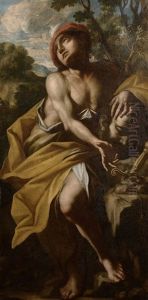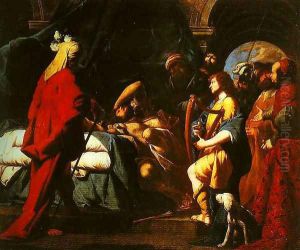Giovanni Battista Spinelli Paintings
Giovanni Battista Spinelli was an Italian Baroque painter, primarily known for his work in Naples during the 17th century. Born around 1613 in Naples, then part of the Spanish Empire, Spinelli was part of a period rich in artistic production and innovation. While not as well-known as some of his contemporaries, Spinelli contributed to the flourishing of the Neapolitan Baroque movement, which was characterized by dramatic expression, rich coloration, and intense chiaroscuro.
Spinelli's early training and influences are not thoroughly documented, but it is likely that he was exposed to the vibrant artistic community in Naples, which included artists like Jusepe de Ribera and the burgeoning influence of Caravaggio's followers. His style suggests that he absorbed the tenebristic style popular at the time, which involved the use of strong contrasts between light and dark to create a sense of volume and drama.
Giovanni Battista Spinelli's work included religious commissions for local churches and altarpieces, as well as portraits and mythological subjects. His paintings are characterized by their dynamic compositions, skillful use of light, and a certain expressive intensity. Unfortunately, many of Spinelli's works have either perished or remain unidentified, which has contributed to his relative obscurity compared to other Baroque masters.
Despite his apparent talent, Spinelli did not achieve the same level of fame as some of his contemporaries. Nevertheless, he was a significant contributor to the Neapolitan school of painting. His works that do survive demonstrate a mastery of the Baroque idiom and provide insight into the artistic milieu of 17th-century Naples.
Giovanni Battista Spinelli died in 1659 in Naples. His legacy is preserved in the works that remain and in the influence he had on the Neapolitan Baroque style. Today, art historians continue to study his contributions to the Italian Baroque and his role within the Neapolitan artistic community of his time.



















